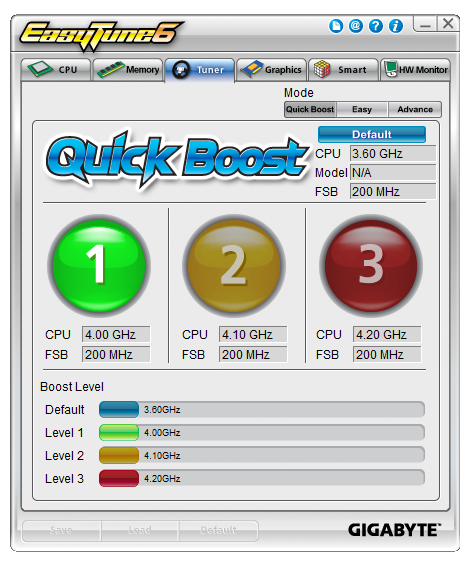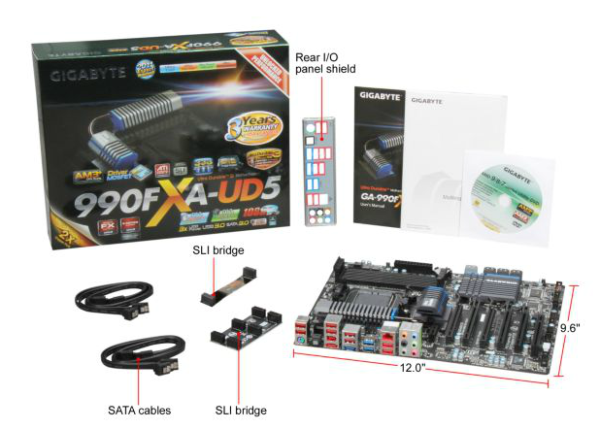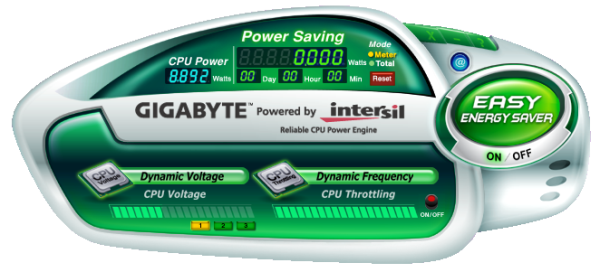990FX Motherboard Roundup with Thuban and Bulldozer – A Second Wind for ASUS, Gigabyte, MSI and Biostar
by Ian Cutress on April 5, 2012 11:00 AM ESTGigabyte 990FXA-UD5 In The Box
Gigabyte packages of late have often been criticized for being bleak and uninteresting. This is typically because Gigabyte employ the model of trying to hit the price point for as cheaply as possible – the extra kit in the box costs, and if Gigabyte can hit a channel board in the next price bracket down, they feel it is beneficial to the consumer. With that being said, this bundle has:
Driver CD
User’s Manual
IO Shield
4 x locking SATA cables
3-way fixed SLI bridge
A long non-fixed SLI bridge
Image Courtesy of Newegg
Board Features
| Gigabyte 990FXA-UD5 | |
| Price | Link to Newegg |
| Size | ATX |
| CPU Interface | AM3+ |
| CPU Support | AMD FX/Phenom II/Athlon II |
| Chipset | AMD 990FX |
| Base Clock Frequency | Auto, 200 MHz to 500 Mhz |
| Core Voltage | Normal, -600 mV to +600 mV |
| CPU Clock Multiplier | Auto, x7 to x35 |
| DRAM Voltage | Normal, 1.025 V to 2.135 V |
| DRAM Command Rate | Auto, 1T or 2T |
| Memory Slots |
Four DDR3 DIMM slots supporting up to 32 GB Up to Dual Channel Support for DDR3, 1066-2000 MHz, |
| Expansion Slots |
3 x PCIe Gen2 x16 (x16/x16 or x16/x8/x8) 2 x PCIe Gen2 x4 1 x PCIe Gen2 x1 1 x PCI |
| Onboard SATA/RAID |
6 x SATA 6 Gbps, Support for RAID 0, 1, 5, 10 2 x SATA 6 Gbps, Support for RAID 0, 1 (Marvell 88SE9172) 2 x eSATA 6 Gbps |
| Onboard |
8 x SATA 6 Gbps (6 SB950, 2 Controller) 4 x Fan Headers 1 x Front Panel Header 1 x S/PDIF Output Header 3 x USB 2.0 Headers 1 x USB 3.0 Headers 1 x IEEE1394 Header 1 x Serial Port Header 1 x Clear CMOS Header 1 x TPM Header |
| Onboard LAN | Realtek 8111E |
| Onboard Audio | Realtek ALC889 |
| Power Connectors |
1 x 24-pin ATX connector 1 x 8-pin 12V connector |
| Fan Headers |
1 x CPU Fan Header 2 x SYS Fan Headers 1 x PWR Fan Headers |
| IO Panel |
1 x Keyboard/Mouse PS2 Port 1 x Optical SPDIF Output 2 x eSATA 3 Gbps 1 x Gigabit Ethernet 2 x USB 3.0 8 x USB 2.0 Audio Outputs |
| BIOS Version | F7h |
| Warranty Period | 3 Years |
To keep costs down Gigabyte has gone with a Realtek Audio/NIC combination which is often sold to manufacturers at a discount as a combo. As always, Gigabyte has included a TPM module header on board for those that require that functionality. What Gigabyte tend to skip out on is a pair of power/reset buttons, or onboard Clear CMOS button rather than pins. I would like to see those rolled out over the range if at all possible.
Software
Where certain other manufacturers have increased and improved their software over the years, Gigabyte has essentially kept to the same set of software for a good while with minimal updates. If you discount the 3D BIOS offerings of X79, all we have to play with is, for the most part, EasyTune – Gigabyte’s monitoring and overclocking center.
EasyTune6
EasyTune takes on a slightly different look if you use a Thuban processor or a Bulldozer processor, especially when it comes to overclocking. The Thuban does not get a set of easy overclock buttons:

In terms of functionality, there is not much we have not seen before from previous Gigabyte outings. Overclocking is done via the base frequency or the multiplier (and depending on the processor, this may work or not as the case may be), and fan controls are a major issue when it comes to Gigabyte products:

From the operating system, this is all we get for fan control of all the controllable headers on board – one little graph with two points. This is rather disappointing, especially when other manufacturers splash out on some more expensive fan headers to get the control in the hands of the user (and then put in the software to back it up).
As EasyTune also features a hardware monitor which polls the various sensors on board for voltages and temperatures every three seconds, this caused issue with a little of our testing, especially in our DPC test. These sensor readings take CPU priority, and hence the DPC results were often 20x bigger than would be reasonable for performing audio on the board with any degree of accuracy. There is a simple solution though – just close ET6.
@BIOS
Gigabyte also has a tool for updating the BIOS. It does exactly what it says on the tin, and is needed from time to time if a big enough change is performed from BIOS version to BIOS version.

Easy Energy Saver
In an effort to appear ‘green’, motherboard vendors are now applying software to their products in an effort to reduce the carbon footprint of the motherboard. In the simplest terms, these software packages attempt to reduce the voltage of the processor at all the load states in order to save energy. The more intelligent systems will also look at other components to save energy, either by power gating through software, or adjusting operational voltages. This is all at the limit on the processor you have at hand (as some will work happily at lower voltages), and at the potential expense of stability. For Gigabyte, this comes in the form of Easy Energy Saver:
Using the ‘intelligent’ driver MOSFETs onboard, they can be controlled and the CPU can be throttled to save power. As a person interested in stability and performance, personally I would shun away from these types of software, but for the more energy conscious, they are here to be used.












57 Comments
View All Comments
mmstick - Thursday, April 5, 2012 - link
The primary problem with AMD FX is that in order to use the full power of the FPU the program needs to be compiled with FMA4 support, else it is only using half of the FPUs, thus making it a quad core. Secondly, many Windows-based programs are compiled with the Intel C+ compiler, so although the FX may support AVX and many other instructions, the compiled program sees it as a non-Intel CPU so it disables those instruction sets, allowing Intel CPUs to be optimized, and AMD CPUs to remain deoptimized. This is what happens when you are up against someone with the most market share, whom has the ability to dictate what instruction sets they want programmers to use. As well, when people say they are going to buy Intel CPUs instead because they claim AMD didn't make a good processor, why do you think they can't be on top of performance? Without R&D budget there isn't much that can be done, and when you face someone who practically owns a monopoly, that makes it even moreso harder to compete.Omoronovo - Thursday, April 5, 2012 - link
The IC++ compiler has not done that since 2010 when they were forced to settle their antitrust dispute with AMD.DigitalFreak - Thursday, April 5, 2012 - link
" This is what happens when you are up against someone with the most market share, whom has the ability to dictate what instruction sets they want programmers to use. As well, when people say they are going to buy Intel CPUs instead because they claim AMD didn't make a good processor, why do you think they can't be on top of performance? Without R&D budget there isn't much that can be done, and when you face someone who practically owns a monopoly, that makes it even moreso harder to compete."Waaaaah. It's always someone else's fault.
anubis44 - Friday, November 9, 2012 - link
"Waaaaah. It's always someone else's fault."Well, sometimes it really IS someone else's fault. If the mafia had it in for you, and cut your brake cables and burnt your house down when you weren't looking, you'd say it's 'someone else's fault' too. Intel's blackmail and threats to suppliers who used AMD processors kinda screwed AMD over just a tad.
That said, I think now that Jim Keller is back at AMD and head of AMD's CPU division, it won't be too long before AMD is seriously back in the game.
Monkeysweat - Thursday, April 5, 2012 - link
I saw them on some of the benchmarks, why didn't you post them along side the AMD benchies for gaming?If we are looking at a roundup of the best of what AMD and it's partners have to offer, I'd like to see what the competing team brings to the table,, just leave em stock and even let the AMD ones get overclocked.
I wouldn't even worry about cherry picking the Intel combos,, just something random.
Beenthere - Thursday, April 5, 2012 - link
AMD has not abandoned the highend CPU market. Their focus may be broadening but that does not mean they will discontinue discrete highend desktop CPUs for at least several years. Eventually everyone except a small group will use APUs as they will deliver the best performance/value proposition. Only extremists will bother with a discrete CPU/GPU with higher power consumption, increased heat and little practical benefit for mainstream users.Articuno - Thursday, April 5, 2012 - link
It's a pretty nice chipset and the lower tier boards are quite cost-effective. Just wish Bulldozer was competitive with Intel, let alone their last gen chips.Mathieu Bourgie - Thursday, April 5, 2012 - link
Thank you for this article Ian.Are there any chance that we'll see a review of the newer FX-6200 CPU or at least have data for it in the CPU bench? Considering that it's 500MHz faster than the model that it's replacing and no major site (or any that I can see) did a review of it, it'd be interesting to see how it performs.
I'm curious to see if it's a valid alternative, in any way, for $170, vs the Intel Core i5-2300 ($180).
I don't expect any miracle for gaming performance, but for workstation workloads (Photoshop, video editing and the like), who knows?
Thanks,
Mathieu
cosminmcm - Thursday, April 5, 2012 - link
There is a review at pcper, a good one. The processor is pretty weak, nothing exciting there. Thuban walks all over it.Mathieu Bourgie - Friday, April 6, 2012 - link
Thanks, I didn't see that.Quite disappointing indeed.
Here's about that Piledriver or Trinity are more competitive.